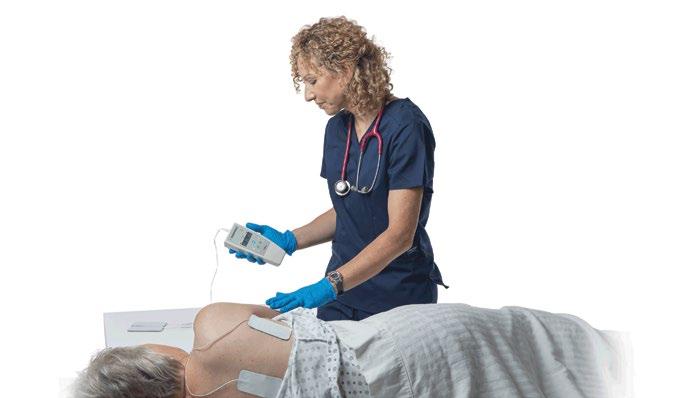
12 minute read
Wednesday, June 8

painful skin condition, caused by erosion of the skin from prolonged exposure to urine or stool from incontinence. IAD is often mistaken for a pressure injury and there are major gaps in current practice, including its identification, prevention, and management. As part of a program of work initiated in NSW Australia to improve incontinence skin care, an instrument was developed “Barakat-Johnson Incontinence-Associated Dermatitis Knowledge tool (KnowIAD).” The KnowIAD is a validated instrument and can be applied to evaluate clinician knowledge on incontinence-associated dermatitis.
Advertisement
WOCNext Night Out
(Networking Event)
7:00 PM CDT – 10:00 PM CDT
IN-PERSON ONLY
CONTACT HOURS: 0
Our in-person party is back! Don’t miss WOCNext® Night Out on Tuesday, June 7, at 7:00 PM CDT at the River Ranch Stockyards for an authentic Texas-style event! River Ranch has the perfect combination of rustic luxury with indoor and outdoor spaces for endless fun, food, and drinks. Meet attendees from around the world and catch up with old friends. Tickets cost $50 per person and will cover a night of dancing, activities, food and a drink ticket.
Transportation to and from River Ranch is supported by Mölnlycke Health Care. A photobooth experience will be supported by Medela.
WEDNESDAY, JUNE 8, 2022
BREAKFAST SYMPOSIA SESSIONS
(S10) NPWT is Good. Is Instillation Therapy Better? Discover NEW Wound Healing Innovations and Clinical & Economic Evidence to Simplify and Enhance Your Experience 7:00 AM CDT - 8:30 AM CDT
(Lecture and Discussion) CONTACT HOURS: 0
Speakers: Elizabeth Faust, MSN, CRNP, CSWS, CWOCN-AP, DAPWCA Luis Fernandez, MD, KHS, KCOEG, FACS, FASAS, FCCP, FCCM, FICS Paul Kim, DPM, MS, FACFAS
SUPPORTED BY 3M HEALTH CARE
• Learn about the brand-new innovations of 2022 to simplify the use of instillation therapy for the management of wounds. • Review the data suggesting instillation therapy is evidence-based, efficient, and cost-effective • Share expert tips and best practices from the use of the new products that saves time during dressing applications on a variety of wounds • Engage in case study discussion with panelists • Take part in a question-and-answer session
(S11) The Impact of Foam Dressings to Prevent and Treat Wounds in Routine Clinical Practice: An Evidence Review 7:00 AM CDT - 8:30 AM CDT
(Lecture and Discussion) CONTACT HOURS: 0
Speaker: Ferne Elsass, MSN, RN, CPN, CWON
SUPPORTED BY SMITH+NEPHEW
Time is precious. Right now, we are witnessing a growing, aging population with multiple health issues, and an increase in chronic wounds. The economic and human cost to treat wounds are high and can quickly spiral out of control. Healthcare providers are asked to do more with less.
Did you know, 70% of dressing changes are driven by schedules? Unnecessary dressing changes consume valuable time which could be used for patients’ other clinical needs, impacting their wellbeing. 24% of patients with chronic wounds have lived with their wound for at least 6 months, with almost 16% remaining unhealed for a year or more. It’s time to take control of chronic wound care, while empowering our patients in their care.
CONCURRENT SESSIONS


(500) Continence and Sexual Health (C, PP)
Speakers: Jim Kovarik, MS, PA-C Tricia Zubert, APRN, CNP
This session will include a review of urinary incontinence and dysfunction, therapeutic treatment options, and a holistic approach to male and female sexual health.

(501) ACEs Body Wisdom: The Rest of the Story (W, O, C, PP)
Speakers: Janice Beitz, PhD, RN, CS, CNOR, CWOCN-AP, CRNP, ANEF, FNAP, FAAN Karen Kennedy-Evans, RN, APRN-BC, FNP
Science emerging from Adverse Childhood Experiences (ACEs) research demonstrates a compelling dose-response relationship with chronic illness and health risk behaviors in adulthood that overlap significantly with risk factors for wound, ostomy, continence care issues. This session will review the science of ACEs, epigenetics, and resilience factors from the perspective of the WOC nurse and focus on trauma-informed approaches to managing affected adults.
(502) Update on the Guideline for Management of Patients with Lower-Extremity Wounds Due to Diabetes Mellitus and/or Neuropathic Disease (W, FN)
Speaker: Phyllis Bonham, PhD, MSN, RN, CWOCN, DPNAP, FAAN
This session will provide a synopsis of the 2021 Guideline for Management of Patients with Lower-Extremity Wounds Due to Diabetes Mellitus and/or Neuropathic Disease from the Wound, Ostomy and Continence Nurses Society™ (WOCN®). The discussion will include: a brief overview of the systematic process used to update/develop the guideline; a summary of evidence-based recommendations from the guideline for screening/ diagnosis, assessment, and management of patients with lower-extremity wounds due to diabetes mellitus (DM) and/ or neuropathic disease (ND).
(503) Challenges of Obtaining Supplies for Ostomy Management Around the World (O, PP) 8:40 AM CDT - 9:40 AM CDT
(Lecture and Discussion) CONTACT HOURS: 1
Speakers: Laurent Olivier Chabal, BSc (CBP), RN, OncPall (Cert), Dip (WH), ET, EAWT Dee Waugh, RN, RM
In developed countries, healthcare professionals and patients have access to vast ranges of ostomy products and systems as well as nurses trained in stoma care. In most developed countries stoma products are fully reimbursed. Appropriate pouch selection can be based on clinical assessment.
In emerging countries, the lack of products available can be challenging and may require the use of unconventional materials when no affordable options are there.
This session will discuss some challenges and creative solutions ET/ Stoma/ Ostomy care Nurses and patients have to deal with over the world.
(504) Yoga for Pelvic Health: Hands-On Workshop (C, PP)
8:40 AM CDT - 10:10 AM CDT 90 (Hands-On Workshop) IN-PERSON ONLY
CONTACT HOURS: 1 .5
Speaker: Dustienne Miller, PT, MS, WCS, CYT
Are you looking for a way to include yoga for pelvic health in your current clinical practice? Learn how to integrate and coordinate the breath and pelvic floor muscles to increase pelvic floor muscle awareness and core strength. Join pelvic health physical therapist Dustienne Miller in this movement-optional educational session.
Due to the nature of this workshop, attendees will be required to wear a mask, unless medically exempt or otherwise unable to wear one.
TICKETED SESSION


(505) Preventing and Reversing Diabetes (PP) 9:50 AM CDT - 10:50 AM CDT
(Lecture and Discussion) CONTACT HOURS: 1
Speaker: Neal Barnard, MD
Type 2 diabetes is a worldwide epidemic, often leading to serious complications and premature mortality. In the context of Covid-19, poorly controlled diabetes greatly increases mortality, and racial disparities in diabetes prevalence have fueled disparities in Covid-19 mortality.
New nutritional interventions for diabetes have shown surprising power in both its prevention and management, and particular attention has been paid to plant-based diets. As a group, individuals following such diets have a lower diabetes prevalence, compared to others. They also tend to have lower cholesterol levels and are less likely to be overweight or hypertensive. In clinical trials, plant-based diets have led to dramatic improvements in diabetes management, typically reducing medication requirements and sometimes making the condition disappear for all intents and purposes.
Type 2 diabetes starts with the build-up of microscopic fat particles inside muscle and liver cells (intramyocellular and hepatocellular lipid), which causes the cells to stop responding normally to insulin, a condition called insulin resistance. A low-fat, plant-based diet—which, of course, has no animal fat and very little fat in general—directly addresses this fundamental cause of diabetes. Magnetic resonance spectroscopy shows that a low-fat plant-based diet reliably reduces intramyocellular and hepatocellular lipid, with the result that insulin resistance can be replaced by increasing insulin sensitivity.
This presentation will describe the rationale for a plant-based diet and how to put it to use, including simple steps that can be used by patients in the clinical setting. Because the intervention relies on food, the result is not only improvement in the identified patient, but often also in the family.
(506) Update on Robotic Surgery for Cystectomy and Preoperative Optimization (W, O, PP) 9:50 AM CDT - 10:50 AM CDT
(Lecture and Discussion) CONTACT HOURS: 1
Speaker: Terran Sims, MSN, ACNP-C, CNN-BC, COCN-C
This session will focus on updates in robotic surgery for cystectomy and optimization of pre and post operative cystectomy patients to improve outcomes. This will include a review of the pros and cons of a robotic approach for cystectomy. A focus on enhanced recovery after surgery coupled with a unique interactive-home monitoring program and the role of the APP and WOC nurse will be discussed. Reducing readmissions is the focus of this surgical program for optimal patient outcomes.
(507A) Starting an Ostomy Clinic: An APRN Experience (O, PP)
Speaker: Jennifer Giannettino, APRN, CWOCN-AP
Advance practice providers are being utilized in many different capacities to address gaps in care within our health care system. In 2012, the Wound, Ostomy and Continence Nursing Certification Board started to offer certification in wound ostomy and continence for providers at an advance practice level. This was done to recognize the benefits that additional training may offer to this patient population including ordering and interpreting diagnostic tests, medication management as well as prevention of emergency department visits/hospitalizations for skin and fluid/electrolyte balance and prescription management for ostomy supplies. This session will describe the transformation of a small nurse-run ostomy clinic into a system-wide nurse practitioner run program.


(507B) Pharmacology in Ostomy Patient Management (O)
Speaker: Janice Colwell, APRN, CWOCN, FAAN
This 30 minutes” bite sized session” will provide you with an overview of the medication management of patients with ostomies. We will look at the common topical medications, GI medications, oral medications for bowel issues (function infection), as well as the medications many of our ostomy patients are on such as immunotherapy and immunosuppressives.

(508) COVID Skin Conditions vs PI: An Update on the Science (W, C, PP) 9:50 AM CDT - 10:50 AM CDT
(Lecture and Discussion) CONTACT HOURS: 1
Speaker: Gary Sibbald, BSc. Md. M.Ed., D.SC (Hon), FRCPC (Med)(Derm), FAAD, MAPWCA, JM
This presentation will explore the common COVID-19 related skin conditions and how COVID-19 prevention and disease management may lower the threshold for pressure injuries. We will examine pressure injuries and the effects of prone positioning in the intensive care unit. Pressure injuries are also related to devices including personal protective equipment and patient care apparatus.
GENERAL SESSIONS
(GS6) Caring for Patients: An International Perspective (W, O, C, PP, FN) 11:00 AM CDT - 12:00 PM CDT
(Lecture and Discussion) CONTACT HOURS: 1
Moderator: Janice Colwell, APRN, CWOCN, FAAN
Speakers: Laurent Olivier Chabal, BSc (CBP), RN, OncPall (Cert), Dip (WH), ET, EAWT Denise Hibbert, RGN, MSc, BSc(hons), DipHe, ONC, STN, FSSCRS Kimberly LeBlanc, PhD, RN, NSWOC, WOCC(C), FCAN Dee Waugh, RN, RM
A panel of experts from Switzerland, Canada, Africa and Saudi Arabia, will discuss issues affecting the provision of care in their own country. Individuals with ostomies, wounds and continence conditions require various levels of care at various time points. The health care system affects access to care, services available, timeliness of health care provision and quality of care by qualified culturally competent providers. This presentation will identify obstacles and challenges in each country.
(GF) Grand Finale 12:00 PM CDT - 12:45 PM CDT
CONTACT HOURS: 0
Speakers: Dea Kent, DNP, RN, NP-C, CWOCN Elizabeth Ayello, PhD, MS, BSN, ETN, RN, CWON, MAPWCA, FAAN

SAVE THE DATE

These presentations are available for viewing on the “On-Demand Content” tab of the virtual event site now through December 31, 2022.
Using Surface Testing Standards to Achieve your Clinical Objectives
PRESENTED BY HILLROM
(This activity is not accredited for nursing Contact Hours)
Speaker: Carrie King MSN, RN, CWOCN
The right surface can make a big difference in keeping your patients’ skin healthy, but how do you know which surface is right for you? Understanding surface testing standards can help you select the right surface for your patient’s condition and achieve your clinical objectives. Learn more with Hillrom who offers a number of specialty surfaces for optimized patient care.
Attendees can hope to learn: 1. An overview of the S3I testing standards 2. An explanation about how these standards are important to your surface selection process & how to easily incorporate them 3. A review of a consensus based algorithm for support surface selection providing guidance to clinicians in selecting support surfaces designed to match individual patient needs
Has the Introduction of Breathable Silicone Rewritten the Future of Ostomy Care?
PRESENTED BY TRIO OSTOMY CARE
(This activity is not accredited for nursing Contact Hours)
Speakers: Karen Ousey, PhD Thomas Swift, MRSC
Peri-stomal skin complication are far too prevalent and have serious quality-of-life consequences for ostomates. In this educational session, Prof. Karen Ousey will discuss the causes of peri-stomal skin damage, and the key role silicone can play to maintain and improve peri-stomal skin. The benefits of silicone in medical devices are well documented in many different product categories. However, silicone has had a minor role in ostomy management, yet may offer significant benefit for ostomates. Dr. Tom Swift a researcher who introduced Sil2, a unique, patented, silicone-based adhesive with Trans-Epidermal Water Loss (TEWL) similar to normal skin, will discuss his scientific findings when comparing the new silicone adhesive to traditional hydrocolloids. These findings include on the effects of skin stripping, breathability, pressures at the skin interface, durability, and absorbency. These scientific findings may be the answer in reducing peri-stomal skin complications impacting ostomate’s quality of life. Finally, you will hear from ostomates themselves on how the science is translating to actual ostomates improving their quality of life. From the lab to the clinician to the ostomate, you will gain understanding of the importance of this new silicone ostomy adhesive in Trio Ostomy Care’s new Genii one-piece silicone ostomy appliances with Sil2 Breathable silicone technology.






